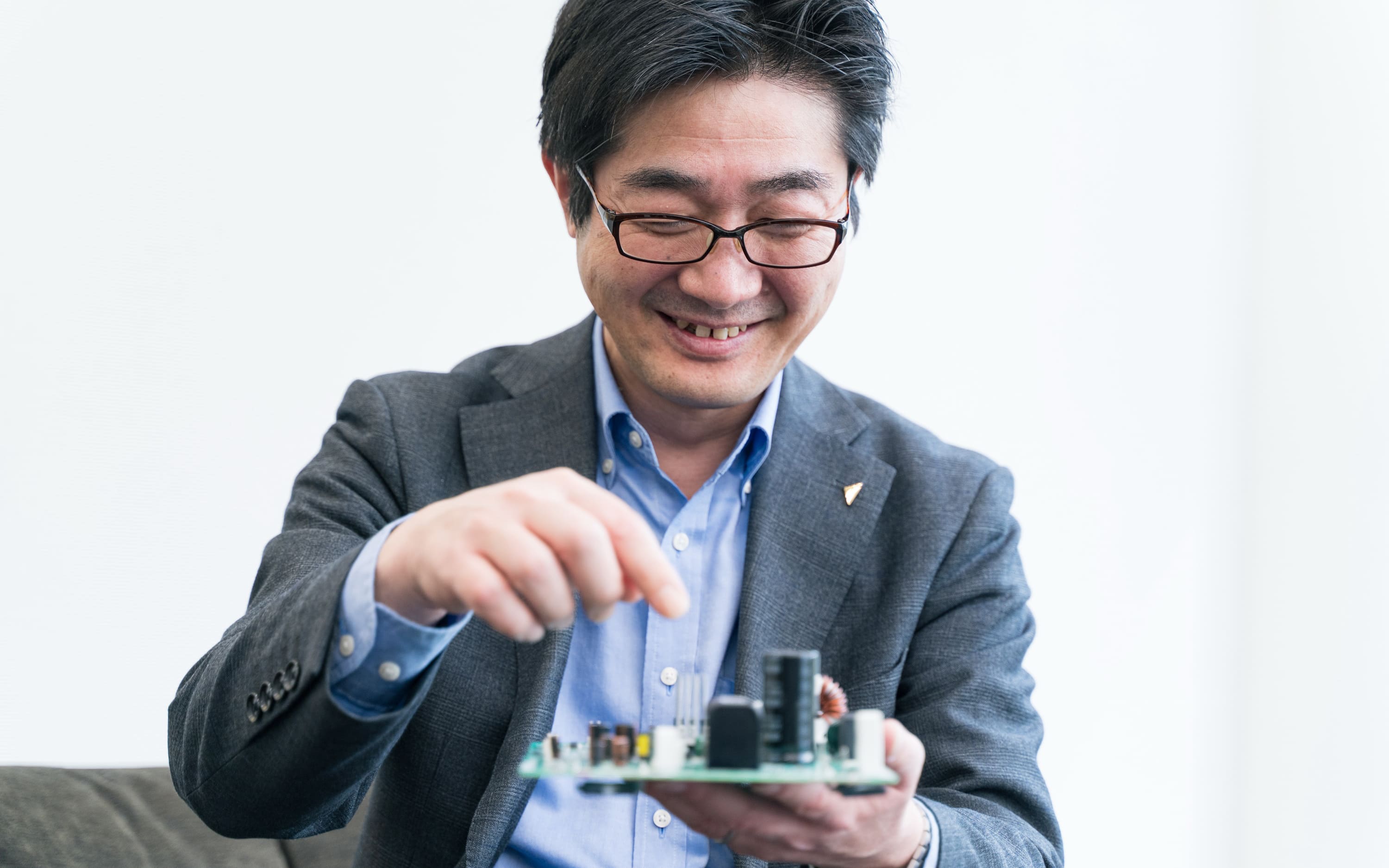--What has your career been like since you joined the company?
Doi: I joined the company in 2005, and this year marks my 17th year. After joining the company, I was assigned to the commercial air conditioner department where I was immersed in new product development for eight years until 2013. There, I was also mainly involved in the development of inverters for air conditioners. When I joined Daikin Industries, I knew that I wanted to work with inverters and have been blessed to work in a department where I could do that. It seems that inverters have been my whole life (laughs).
NEWS
Three-phase Electrolytic Capacitor-less Inverter Shatters the Mold!
FEATURE
2022.10.25
Inverters are essential for flexible control of motors used in air conditioner compressors and other equipment. Instead of simply controlling ON/OFF, inverter technology can smoothly fine-tune rotation speed to reduce wasted energy and contribute to energy conservation. Until recently, electrolytic capacitors had been indispensable for the inverter control circuit of multi-split type air conditioners for commercial buildings. Mr. Hirotaka Doi, an engineer in the Inverter Technologies Group at TIC, developed the technology that eliminates the need for electrolytic capacitors. We asked him about the difficulties he faced in the development of this technology.
Living the dream of inverters in university and at Daikin
--How did you spend your school days before joining the company? Why did you choose Daikin Industries as your place of employment?
Doi: Since childhood, I’ve always loved taking machines apart and tinkering with them. In high school, I chose science courses for my electives and then entered the electrical engineering department at university. Knowing that I wanted to work in the electrical field in the future, I wrote my graduation thesis on the optimal control of inverters. Because I was born and raised in the Kansai region, I wanted to stay here, so when Daikin offered me the chance to work in Kansai in my field of study, I jumped at the opportunity.
Doi: Since childhood, I’ve always loved taking machines apart and tinkering with them. In high school, I chose science courses for my electives and then entered the electrical engineering department at university. Knowing that I wanted to work in the electrical field in the future, I wrote my graduation thesis on the optimal control of inverters. Because I was born and raised in the Kansai region, I wanted to stay here, so when Daikin offered me the chance to work in Kansai in my field of study, I jumped at the opportunity.
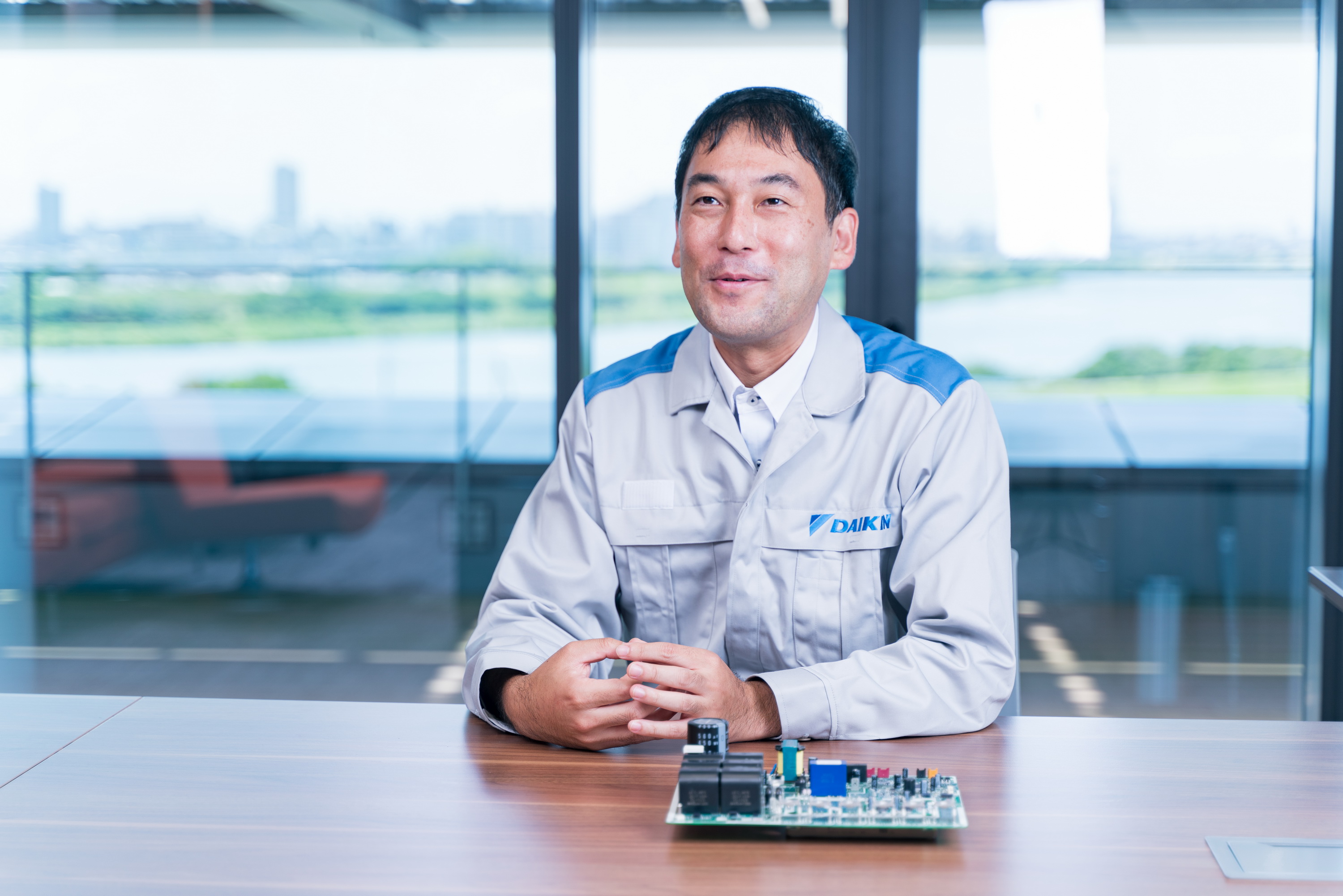
--When did you start development of the three-phase electrolytic capacitor-less inverter, and how many development members were there?
Doi: It was around 2013 when I first came up with a plan to develop an electrolytic capacitor-less inverter for multi-split type air conditioners for commercial buildings, and it took us about four years to develop one (three years for technical development and one year for mass production development). There were about 10 members in total: two in hardware design, including myself, three or four in control, and two each in charge of motors and compressors
A new inverter prototype was completed in the first two years. Development went quickly since we already had electrolytic capacitor-less technology for residential and light commercial air conditioners and could leverage our technological expertise without needing to develop everything from scratch. In the third year, we connected the prototype to motors and compressors to check product integrity and rushed to make sure the prototype could be installed in products. At the same time, we promoted its performance around the industry. In the last year, we made final adjustments for mass production.
Doi: It was around 2013 when I first came up with a plan to develop an electrolytic capacitor-less inverter for multi-split type air conditioners for commercial buildings, and it took us about four years to develop one (three years for technical development and one year for mass production development). There were about 10 members in total: two in hardware design, including myself, three or four in control, and two each in charge of motors and compressors
A new inverter prototype was completed in the first two years. Development went quickly since we already had electrolytic capacitor-less technology for residential and light commercial air conditioners and could leverage our technological expertise without needing to develop everything from scratch. In the third year, we connected the prototype to motors and compressors to check product integrity and rushed to make sure the prototype could be installed in products. At the same time, we promoted its performance around the industry. In the last year, we made final adjustments for mass production.
Unconventional thinking makes electrolytic capacitors obsolete
--What made you think of removing the electrolytic capacitor from the inverter control circuit?
Doi: The electrolytic capacitor in an inverter smooths out fluctuations in the voltage converted from AC to DC through a rectifier to supply a constant, stable voltage to the inverter. If the power supply is unstable, inverter control is also affected, resulting in unstable operation with fluctuations in motor torque and generation of a whining noise during rotation. This condition made it standard practice at the time to equip electrolytic capacitors for stabilization.
However, electrolytic capacitors are limited life components that degrade over time and have a relatively short lifespan, making them a major factor in determining inverter life. So, to achieve an inverter with an unlimited lifespan, we wanted to remove electrolytic capacitors from the equation. Since Daikin Industries is a company that considers all possibilities, we looked beyond conventional wisdom that said capacitors were essential for inverters. Ten years earlier, we had achieved electrolytic capacitor-less inverters for residential use. However, whereas single-phase power supply for residential use has small capacitance, three-phase power supply for commercial use has large capacitance, so further development of new technology was required.
Doi: The electrolytic capacitor in an inverter smooths out fluctuations in the voltage converted from AC to DC through a rectifier to supply a constant, stable voltage to the inverter. If the power supply is unstable, inverter control is also affected, resulting in unstable operation with fluctuations in motor torque and generation of a whining noise during rotation. This condition made it standard practice at the time to equip electrolytic capacitors for stabilization.
However, electrolytic capacitors are limited life components that degrade over time and have a relatively short lifespan, making them a major factor in determining inverter life. So, to achieve an inverter with an unlimited lifespan, we wanted to remove electrolytic capacitors from the equation. Since Daikin Industries is a company that considers all possibilities, we looked beyond conventional wisdom that said capacitors were essential for inverters. Ten years earlier, we had achieved electrolytic capacitor-less inverters for residential use. However, whereas single-phase power supply for residential use has small capacitance, three-phase power supply for commercial use has large capacitance, so further development of new technology was required.
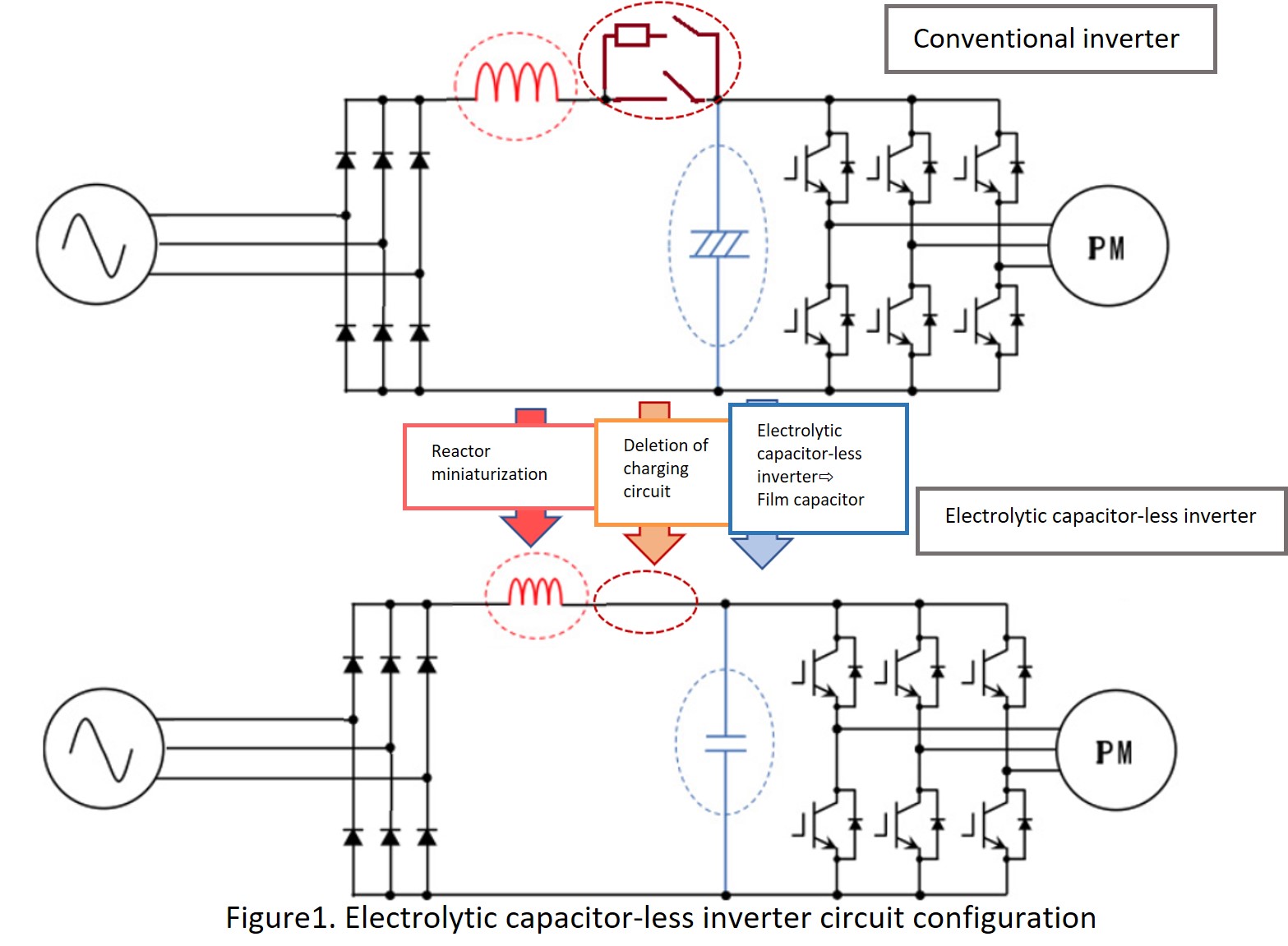
Fig. 1 shows the circuit configuration of a three-phase electrolytic capacitor-less inverter used in a commercial air conditioner.
For example, at that time, six large-capacity electrolytic capacitors were mounted on the board for commercial use. These capacitors were removed and replaced with small capacitors with a capacitance of about 1/30th, resulting in a cost reduction. This technology has enabled us to reduce costs by about 40% compared to conventional inverters. In addition to eliminating electrolytic capacitors, it is also possible to downsize the reactor to improve the power factor (the percentage of power flowing that is effectively utilized) and to eliminate the charging circuit used to charge the electrolytic capacitors. This is a win-win situation.
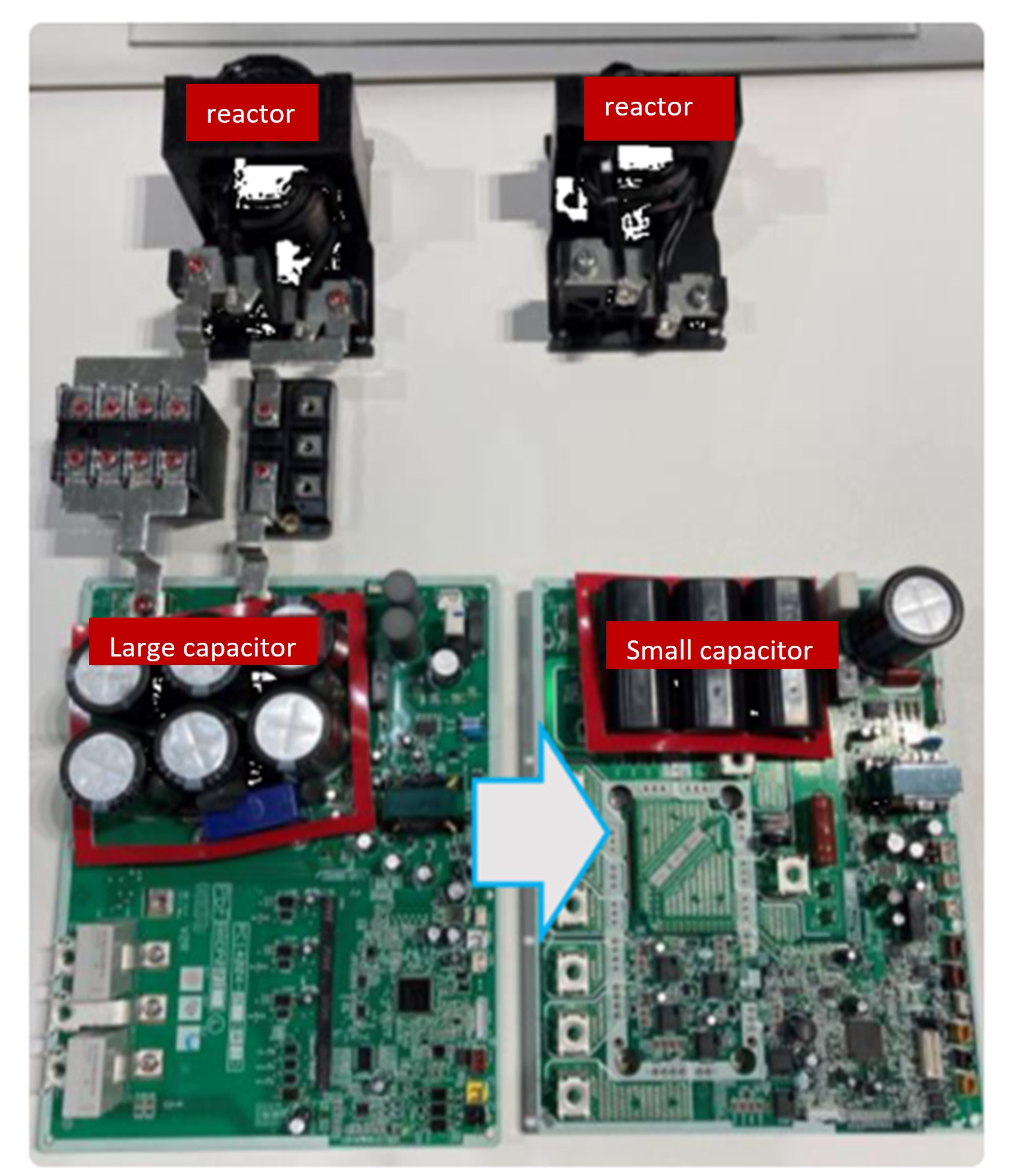
This is a comparison of a conventional board with electrolytic capacitors and a new board improved without electrolytic capacitors. 960μF x 6 pieces = approx. 6000μF electrolytic capacitors were reduced to 30μF x 6 pieces = 180μ, which is 1/30 of the capacity, resulting in cost reductions.
Unrivaled Daikin inverter waveform control technology
--What enabled Daikin to realize capacitor-less inverters?
Doi: If the electrolytic capacitor is eliminated, the voltage smoothing function is lost, so the power in the inverter section constantly fluctuates. As I mentioned earlier, the motor torque fluctuates, and this affects noise and vibration of the compressor. In order to reduce the impact, some alternative function other than the capacitor must be used to absorb the power fluctuations. Here, Daikin leverages its "inverter waveform control technology.” By feeding back DC voltage and motor current information of the inverter in short cycles of 0.0001 seconds or less and detecting the frequency information of the power supply, the software performs compensation control to offset the power pulsations caused by voltage fluctuations, thereby stabilizing the system. This is an extremely difficult proprietary technology in which we hold the patent, ensuring that no other company can copy us.
Doi: If the electrolytic capacitor is eliminated, the voltage smoothing function is lost, so the power in the inverter section constantly fluctuates. As I mentioned earlier, the motor torque fluctuates, and this affects noise and vibration of the compressor. In order to reduce the impact, some alternative function other than the capacitor must be used to absorb the power fluctuations. Here, Daikin leverages its "inverter waveform control technology.” By feeding back DC voltage and motor current information of the inverter in short cycles of 0.0001 seconds or less and detecting the frequency information of the power supply, the software performs compensation control to offset the power pulsations caused by voltage fluctuations, thereby stabilizing the system. This is an extremely difficult proprietary technology in which we hold the patent, ensuring that no other company can copy us.
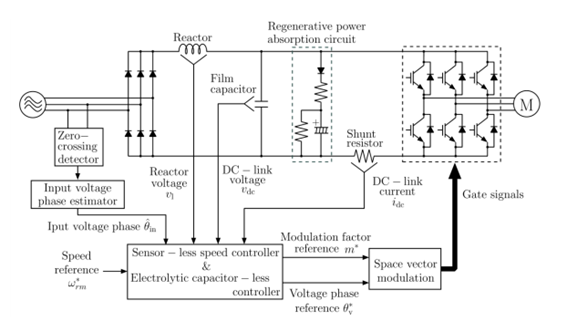
Daikin’s electrolytic capacitor-less technology achieves an alternative function to eliminate noise of harmonic components by software through our unique "inverter waveform control," which is unrivaled by other companies.
-- That’s impressive. However, isn’t the inverter itself prone to generating noise of harmonic components and having an effect?
Doi: If electrolytic capacitors are eliminated, consideration must also be given to the harmonic currents that flow out to the power supply side. Since each country has different standards for harmonic currents, it is necessary to suppress harmonic currents by waveform control of the inverter to conform to the standards of that country. This harmonic current suppression control is achieved by feeding back the voltage generated at both ends of the reactor.Daikin's advantage lies in the fact that it possesses both software and hardware technologies that enable both stable motor operation and noise suppression of harmonic components.
Doi: If electrolytic capacitors are eliminated, consideration must also be given to the harmonic currents that flow out to the power supply side. Since each country has different standards for harmonic currents, it is necessary to suppress harmonic currents by waveform control of the inverter to conform to the standards of that country. This harmonic current suppression control is achieved by feeding back the voltage generated at both ends of the reactor.Daikin's advantage lies in the fact that it possesses both software and hardware technologies that enable both stable motor operation and noise suppression of harmonic components.
A "Mixed Martial Arts" development approach requiring coordination between departments
--What hurdles did you face in establishing electrolytic capacitor-less technology?
Doi: Electrolytic capacitor-less technology leads to longer service life and cost reductions, but it also brings disadvantages to motors and compressors, causing other departments to voice their objections. For example, once the capacitor capacity is reduced and control is made to suppress power pulsation, the voltage component of the inverter is used for control, which results in a lower voltage available for the motor side and prevents speed from increasing. Conversely, there was concern that increasing current would raise motor winding temperature. This made it necessary to change motor and compressor designs to match the electrolytic capacitor-less inverter, instead of using the existing inverter motors and compressors.
In moving forward with development, the benefits to the overall product had to be demonstrated to the relevant departments, and we worked hard to communicate those benefits to them. This aspect was the most difficult part of the project. In the end, we had the motor design reviewed and adapted to our inverter specifications. At that time, we carefully explained the benefits of changing the motor design while showing specific test data.
Doi: Electrolytic capacitor-less technology leads to longer service life and cost reductions, but it also brings disadvantages to motors and compressors, causing other departments to voice their objections. For example, once the capacitor capacity is reduced and control is made to suppress power pulsation, the voltage component of the inverter is used for control, which results in a lower voltage available for the motor side and prevents speed from increasing. Conversely, there was concern that increasing current would raise motor winding temperature. This made it necessary to change motor and compressor designs to match the electrolytic capacitor-less inverter, instead of using the existing inverter motors and compressors.
In moving forward with development, the benefits to the overall product had to be demonstrated to the relevant departments, and we worked hard to communicate those benefits to them. This aspect was the most difficult part of the project. In the end, we had the motor design reviewed and adapted to our inverter specifications. At that time, we carefully explained the benefits of changing the motor design while showing specific test data.
--What justification did you actually give to persuade everyone involved?
Doi: Eliminating electrolytic capacitors from inverters changes the electrical characteristics pertaining to the motor including current, voltage, and power factor. This makes it important to design the optimum motor accordingly. So, we started by taking data on electrical characteristics with prototypes, checking whether they were within the acceptable ranges, and then gradually developing them. It was still very difficult to manage the interpersonal relationships. In wanting to achieve something radically different, we had to ensure that everyone involved was onboard as we moved forward. Let me tell you, obtaining and maintaining a consensus can be exhausting at times.
Working on something new sometimes requires you to deviate from your original plan, and our something new was a prototype that was inadequately tuned and sometimes stopped during testing. We brought measuring equipment to the worksite for that reason, so whenever trouble happened, we thoroughly investigated the cause and patiently explained the situation to the relevant departments. In this type of project, divergent skillsets are merged through the cooperation of many people, even though we sometimes metaphorically butted heads. For this reason, inverter development can sometimes resemble a type of "mixed martial art" event. While some sharp criticisms were made to us during the development process, we ultimately conveyed our vision. When we ran into obstacles, those same people with harsh comments supported us like a family and warmly offered us advice and encouragement.
Doi: Eliminating electrolytic capacitors from inverters changes the electrical characteristics pertaining to the motor including current, voltage, and power factor. This makes it important to design the optimum motor accordingly. So, we started by taking data on electrical characteristics with prototypes, checking whether they were within the acceptable ranges, and then gradually developing them. It was still very difficult to manage the interpersonal relationships. In wanting to achieve something radically different, we had to ensure that everyone involved was onboard as we moved forward. Let me tell you, obtaining and maintaining a consensus can be exhausting at times.
Working on something new sometimes requires you to deviate from your original plan, and our something new was a prototype that was inadequately tuned and sometimes stopped during testing. We brought measuring equipment to the worksite for that reason, so whenever trouble happened, we thoroughly investigated the cause and patiently explained the situation to the relevant departments. In this type of project, divergent skillsets are merged through the cooperation of many people, even though we sometimes metaphorically butted heads. For this reason, inverter development can sometimes resemble a type of "mixed martial art" event. While some sharp criticisms were made to us during the development process, we ultimately conveyed our vision. When we ran into obstacles, those same people with harsh comments supported us like a family and warmly offered us advice and encouragement.
Ideal workplace for engineers that maximizes the abilities of each individual
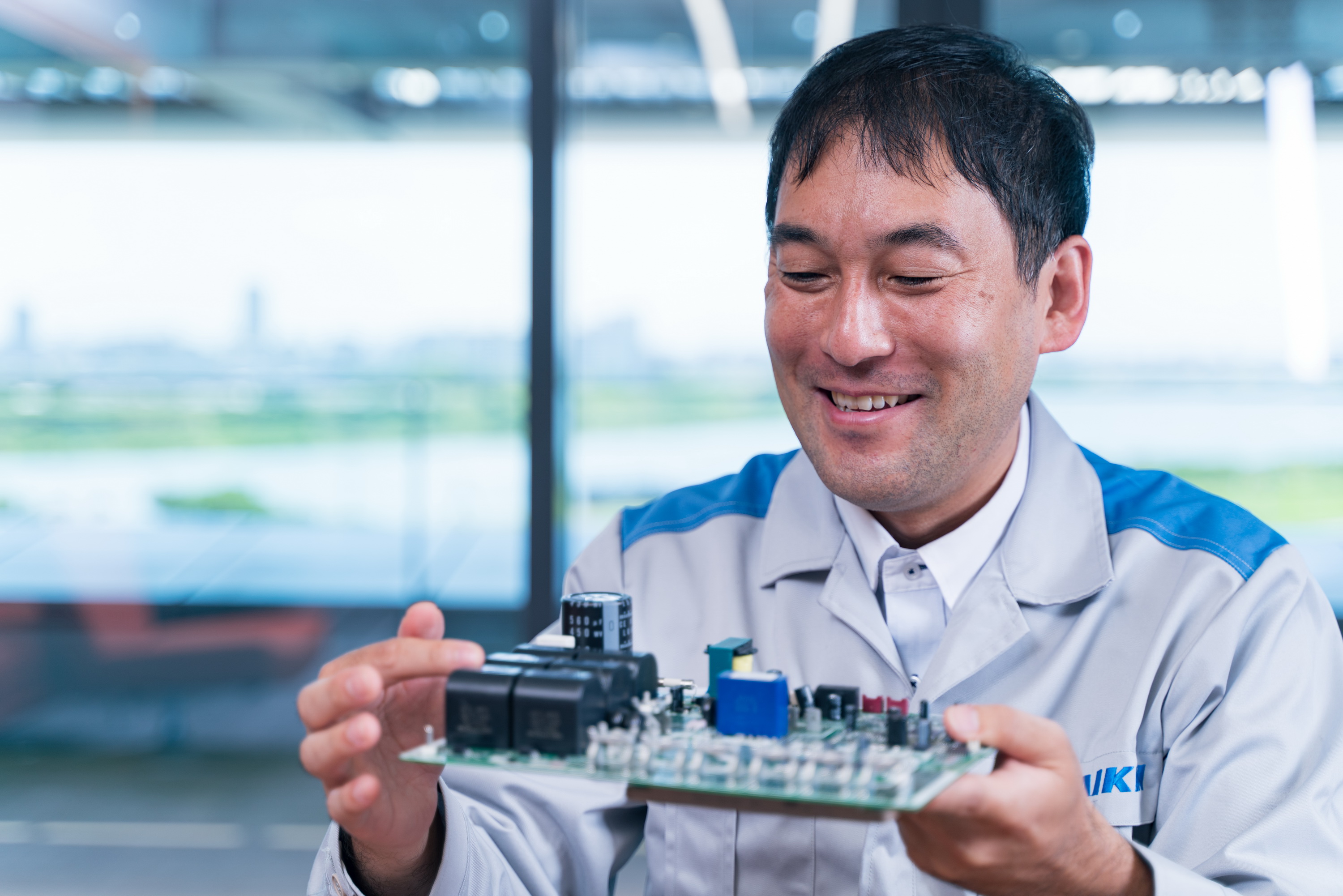
--The Daikin environment seems to bring out the best in an engineer. It must be a rewarding place to work.
Doi: I had my share of difficulties, but I’ve been fortunate to utilize all of my knowledge and know-how in the entire 11 years since I have been involved in product development. And I think we’ve created many good products. In the process, I maximized my own performance and enlisted the help of others when things were difficult for me to go it alone. The extent to which I could involve others was extremely important. I also learned the importance of moving forward with a firm vision toward a big goal. This electrolytic capacitor-less technology can be applied to all inverters. We have already obtained a basic patent for this technology, and no other company can enter the market.
Doi: I had my share of difficulties, but I’ve been fortunate to utilize all of my knowledge and know-how in the entire 11 years since I have been involved in product development. And I think we’ve created many good products. In the process, I maximized my own performance and enlisted the help of others when things were difficult for me to go it alone. The extent to which I could involve others was extremely important. I also learned the importance of moving forward with a firm vision toward a big goal. This electrolytic capacitor-less technology can be applied to all inverters. We have already obtained a basic patent for this technology, and no other company can enter the market.
--Lastly, do you have any advice for junior colleagues who are about to join Daikin Industries?
Doi: In my business, there are many engineers involved in the hardware and software control of inverters, and we are especially active, including in the development of our own elemental technologies for both motors and compressors. That is why I believe that Daikin Industries is a company where I have been able to realize my ideal work situation. Inverter development is also done in collaboration through cross-departmental cooperation with each department, so if a problem arises, we can easily consult with other departments, and the speed at which we can respond is very fast. No matter your position in the company, a workplace that draws out your individual abilities to the maximum is waiting for you.
Doi: In my business, there are many engineers involved in the hardware and software control of inverters, and we are especially active, including in the development of our own elemental technologies for both motors and compressors. That is why I believe that Daikin Industries is a company where I have been able to realize my ideal work situation. Inverter development is also done in collaboration through cross-departmental cooperation with each department, so if a problem arises, we can easily consult with other departments, and the speed at which we can respond is very fast. No matter your position in the company, a workplace that draws out your individual abilities to the maximum is waiting for you.
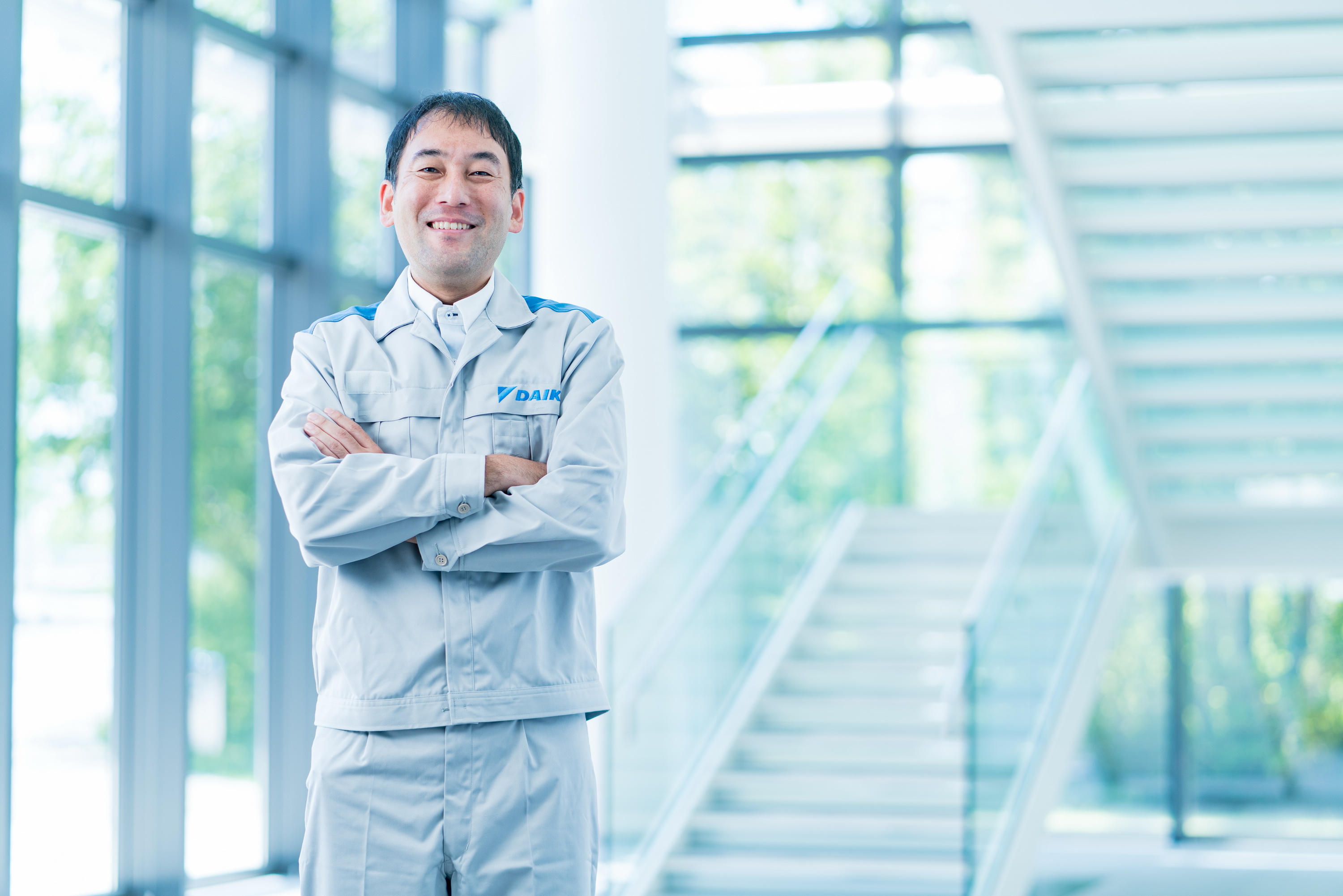
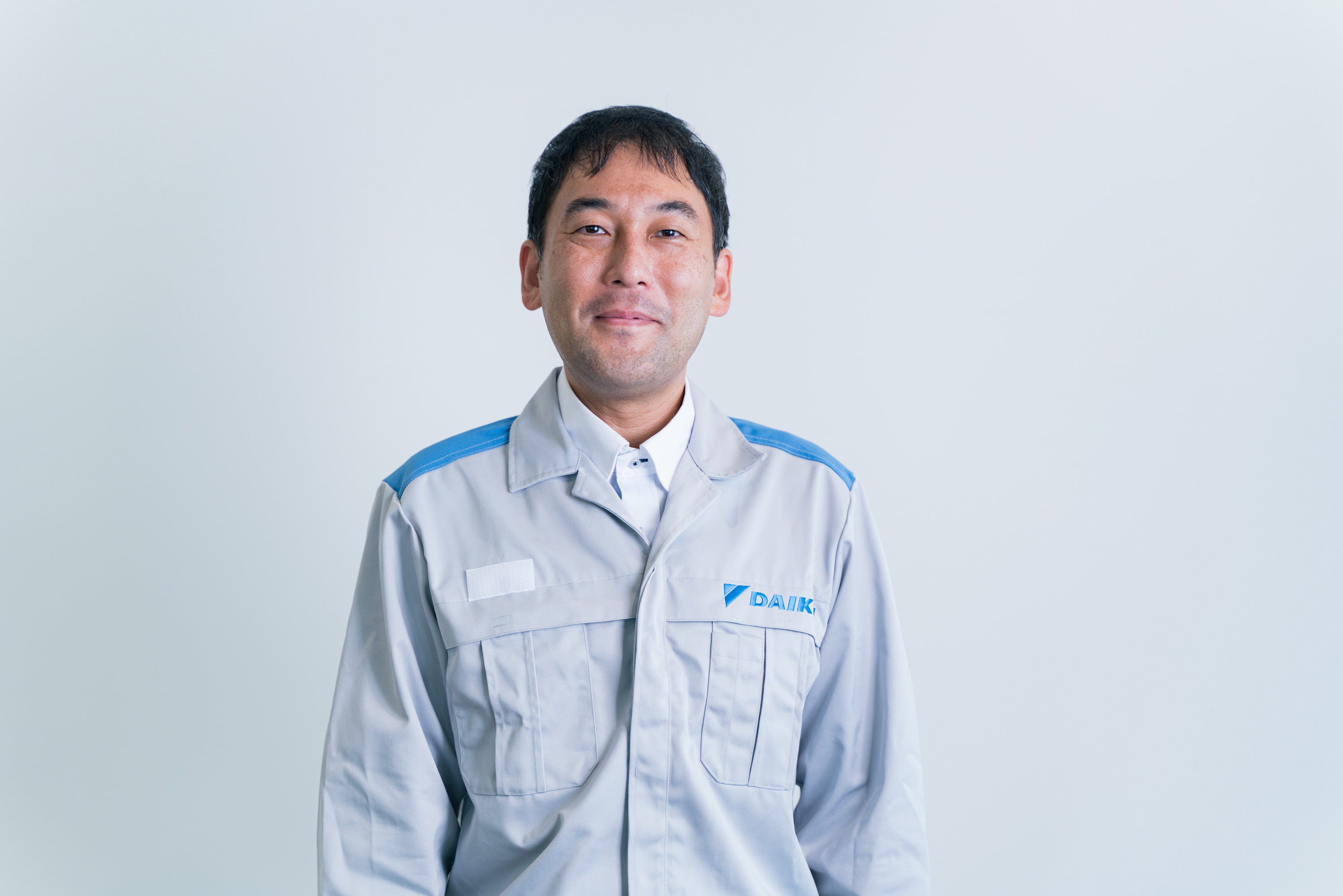
Hirotaka Doi
Technology and Innovation Center
Joined the company in April 2005. Born in Hyogo Prefecture.
Being responsible for the hardware technical development of inverters. To continue expanding Daikin's unique inverter technology worldwide, I want to keep challenging myself every day.
Technology and Innovation Center
Joined the company in April 2005. Born in Hyogo Prefecture.
Being responsible for the hardware technical development of inverters. To continue expanding Daikin's unique inverter technology worldwide, I want to keep challenging myself every day.
Related article






